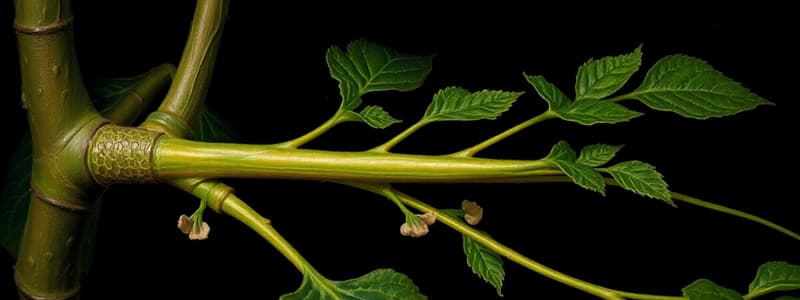Podcast
Questions and Answers
If a plant's phloem tissue were damaged, which process would be most directly affected?
If a plant's phloem tissue were damaged, which process would be most directly affected?
- The synthesis of glucose during photosynthesis.
- The absorption of mineral salts from the soil.
- The transport of sucrose from the leaves to other parts of the plant. (correct)
- The transport of water from the roots to the leaves.
In the context of water transport in plants, what is the primary role of root pressure?
In the context of water transport in plants, what is the primary role of root pressure?
- To facilitate the movement of sucrose from leaves to roots.
- To increase the surface area for absorption of water and mineral salts.
- To initiate the movement of water from the roots into the xylem vessels. (correct)
- To regulate the rate of transpiration in leaves.
Which statement accurately describes the relationship between glucose, sucrose, and their transport within a plant?
Which statement accurately describes the relationship between glucose, sucrose, and their transport within a plant?
- Both glucose and sucrose are transported simultaneously through xylem and phloem.
- Glucose, produced in the leaves, is converted to sucrose for transport via phloem.
- Glucose is transported directly from the roots to the leaves via xylem vessels. (correct)
- Sucrose is converted into glucose for efficient transport through phloem tissue.
What is the functional significance of the tiny root hairs present in plants?
What is the functional significance of the tiny root hairs present in plants?
How does the arrangement of vascular tissue in leaves contribute to their function?
How does the arrangement of vascular tissue in leaves contribute to their function?
Under what conditions would the rate of water movement from the soil into the root hair cells be highest?
Under what conditions would the rate of water movement from the soil into the root hair cells be highest?
What is the role of osmosis in the context of water uptake by plant roots?
What is the role of osmosis in the context of water uptake by plant roots?
Which of the following accurately describes the composition and function of vascular tissue in plants?
Which of the following accurately describes the composition and function of vascular tissue in plants?
If a scientist discovers a mutant plant species lacking tiny root hairs, what would be the most likely consequence for the plant's physiology?
If a scientist discovers a mutant plant species lacking tiny root hairs, what would be the most likely consequence for the plant's physiology?
If a plant is experiencing a period of high transpiration, what adjustments might occur in its water transport mechanisms to maintain homeostasis?
If a plant is experiencing a period of high transpiration, what adjustments might occur in its water transport mechanisms to maintain homeostasis?
Flashcards
Plant Transport System
Plant Transport System
Specialized tissues that transport water, mineral salts, and food throughout the plant.
Xylem Vessels
Xylem Vessels
Vessels that transport water and mineral salts from the roots to the leaves.
Glucose to Sucrose
Glucose to Sucrose
Food (glucose) created during photosynthesis is converted to sucrose for transport by phloem.
Phloem Tissue
Phloem Tissue
Signup and view all the flashcards
Vascular Tissue
Vascular Tissue
Signup and view all the flashcards
Veins in Leaves
Veins in Leaves
Signup and view all the flashcards
Tiny Root Hairs
Tiny Root Hairs
Signup and view all the flashcards
Osmosis in Roots
Osmosis in Roots
Signup and view all the flashcards
Root Pressure
Root Pressure
Signup and view all the flashcards
Study Notes
- Plants possess a specialized transport system consisting of tissues that transport water, mineral salts, and food.
- Water and mineral salts travel from the roots to the leaves via xylem vessels.
- The food produced in the leaves of a plant is glucose.
- Glucose is a product of photosynthesis.
- For transport, glucose converts to sucrose.
- Sucrose travels from the leaves to the rest of the plant through phloem tissue.
- Xylem and phloem compose the vascular tissue throughout the plant.
- Vascular tissue in leaves is referred to as veins.
- Tiny root hairs increase the surface area for water and mineral salt absorption.
- Water travels down the concentration gradient from the soil to root hair cells through osmosis.
- Water moves by osmosis from cell to cell until it reaches the xylem vessels, resulting in root pressure.
Studying That Suits You
Use AI to generate personalized quizzes and flashcards to suit your learning preferences.




